Setting the standard: The story behind ITV Sport’s new virtual presentation hub
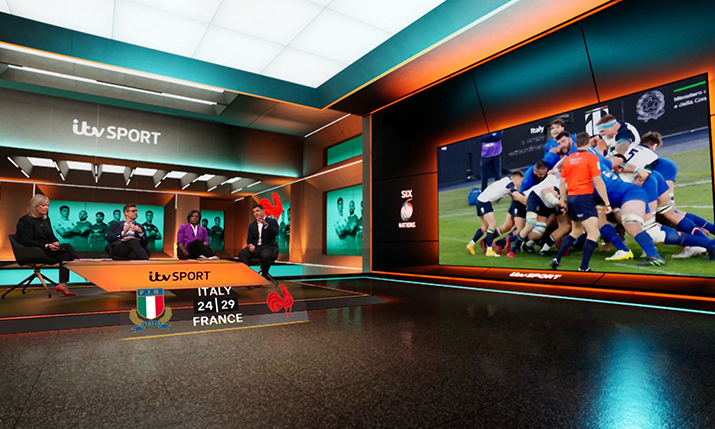
Paul McNamara, senior director and executive producer for major events at ITV Sport, talks to SVG Europe about the origin of the broadcaster’s new virtual studio set, provides an insight into what it’s like to direct in a virtual environment, and reveals that rugby won’t be the only sport to make use of it.
The 2023 Six Nations is now well underway with Ireland topping the standings at a tournament that includes a clutch of new additions: a shot clock to reduce delays, revised water carrier rules, and a fresh head coach for England. But these are not the only interesting differentials at this year’s Championship.
ITV Sport, one of two UK rights holders (the other being the BBC), has introduced a new virtual studio set to support the coverage of matches where it is not doing the on-site host broadcast.
The set, which made its debut during Italy vs France in week 1 of the competition, is acting as a hub for the public service broadcaster, allowing enhanced pre-match, half-time and full-time presentation and analysis to take place in London while the match action happens in Rome, Paris, Cardiff, Dublin or Glasgow.
“I wanted even the smallest shows to look great. And I wanted the big shows to look amazing. I wanted a sense of depth and a sense of scale. In a physical studio, it is very, very hard to get that sense of depth.”
Built in Unreal Engine, controlled using Brainstorm, and operated by MOOV, the set features a physical desk and then multiple virtual stand-up and seated presentation positions featuring live VR screens.
AR graphics elements – from team line-ups to manager avatars – can be added too, created by MOOV, with tracking done using Mo-Sys Star Tracker.
The physical green screen set where the presenters and pundits share their expertise and insight is housed at Timeline’s Ealing Broadcast Centre in West London. It features three pedestal cameras and the all-important jib, on which most of the graphics land.
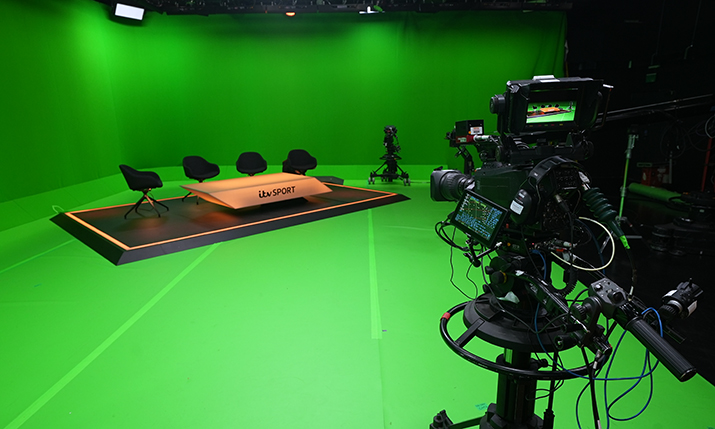
Perhaps most interestingly of all, it’s not just a set that will be used for the rugby. It has been designed as a hub for (potentially) any of ITV Sport’s output, to be used as and when required, as Paul McNamara, senior director and executive producer for major events at ITV told SVG Europe. And, although it took 10 months from concept to on-air, it’s origins go back still further.
“You can trace it back to when we moved out of The London Studios [an ITV-owned facility that closed in April 2018],” explains McNamara.
“All of our sets had been designed for that space. And we had used a mixture of studios ever since. It worked fine but it wasn’t perfect. That was one factor. The other factor was that when we were planning for the Qatar 2022 World Cup, we planned to present on site. But as we were getting closer to the tournament we were still coming up against issues regarding vaccinations, and what the infrastructure and the administration would be. We were confident but we were never 100% that we would get there. There was always a sense that the entry process for personnel might change.
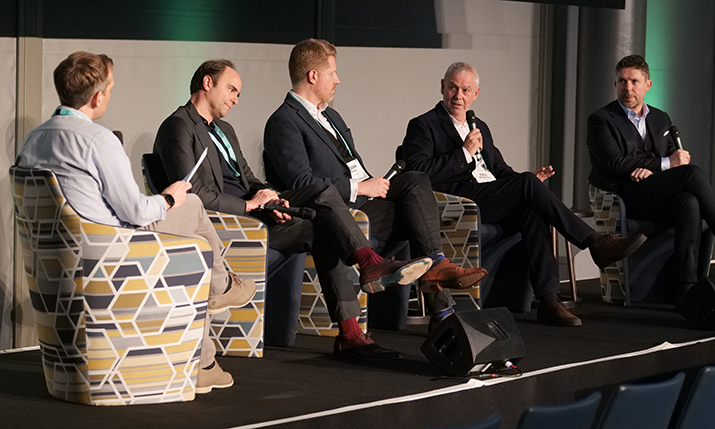
Paul McNamara (second from right) speaking at SVG Europe’s Football Summit in 2022
“So with that in mind, we thought it would be prudent to have a backup studio. But we didn’t want to create a vast physical studio if it wasn’t going to be used. So then we got on a roll: could we create something that would be useful for Qatar, that could operate as primarily a studio for the World Cup, and be good enough and appropriate enough for that? But also be a studio for us going forward? That’s where my thinking was and how I sold the concept into the business.”
A pitching process then followed, primarily with companies and designers that ITV has worked with previously. The brief was pretty simple: a versatile space with a sense of depth and a sense of scale. Oh yeah, and it had to look incredible.
“I wanted an ITV Sport hub that could cover the range of sports that we have in our portfolio,” continues McNamara. “Something that is multi-functional so we can put in the smallest of shows and have a two-person stand-up operation at the lower end of our budget. Or have a Six Nations, or a major tournament, at the other end.
“I wanted even the smallest shows to look great. And I wanted the big shows to look amazing. I wanted a sense of depth and a sense of scale. In a physical studio, it is very, very hard to get that sense of depth. And I wanted flexibility. For the presenters to walk or sit.”
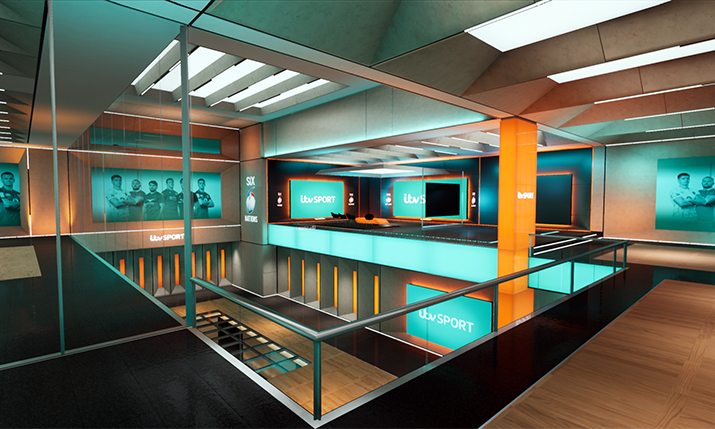
There was also a desire to provide a ‘behind the scenes’ narrative for the viewer.
“I wanted the viewer to see the presenter in one area, but then be able look into another area as well and be thinking: ‘maybe later on they are setting up for the horse racing or the football.’ The feeling that it was a hub with lots of areas and activity.”
The designers chosen to realise this concept were Jim Mann of Lightwell and Toby Kalitowski from BK Design Projects.
“They really got the brief,” says McNamara. “They really got that high-end show look, but they also understood that we might need to cover [a low-budget show] for a few days. I feel they have given me an amazing look across the board.”
A working committee was then set up that included McNamara, Mann and Kalitowski plus ITV Sport technical director Tony Cahalane, director of photography Chris Hollier, and motion graphics designer and director Kim Teddy.
“During the testing phase, we looked to lock down the creative possibilities to give it some structure. On the day [of a match], you have to make a show. You have to editorialise. You can’t just float around in an endless way.”
Timeline and MOOV were then added and once the concept had been firmed up, the focus turned to deployment, testing and, importantly, narrowing down the creative options.
“The possibilities with VR and AR are endless and from a creative perspective that is quite a dangerous thing,” says McNamara candidly.
“So during the testing phase, we looked to lock down those possibilities to give it some structure. On the day [of a match], you have to make a show. You have to editorialise. You can’t just float around in an endless way.”
This has led to the creation of a pseudo playbook for directors and operators.
“To a degree, there is a style guide because you’re trying to narrow down the infinity of possibilities. We say, here are the 10 options for camera right. Here are the 10 options for camera left. You have to break it down to start with. Otherwise, people will be floundering around.”
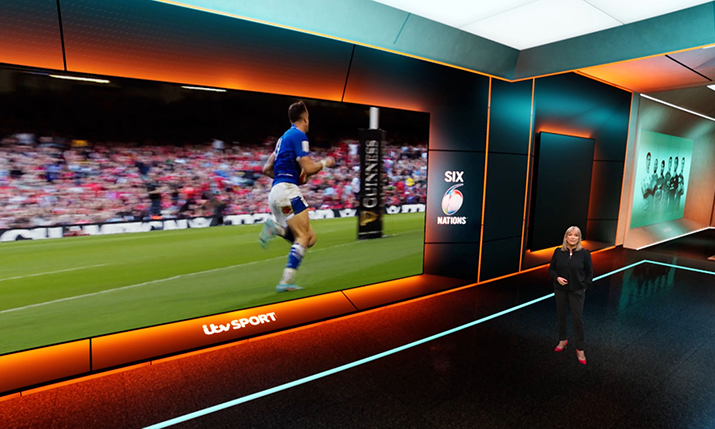
Once the studio set is designed and operational, and ground rules are in place, the secret to successfully directing virtual sports presentation is know-how, planning, and having a top-notch jib operator.
“The jib op [Steve Fuller] is very skilled because he’s moving around a green space and has to hit marks. Most of the graphics land on the jib so consistency is so important. When I am directing it, I am clearing the jib from one shot to another shot. I am asking MOOV to animate the graphics. We are checking that the jib has got the whole shot in. Then we are de-animating it before we actually take the shot live. It’s quite a quick and tricky process. But once you have nailed that down it gets more fluid.”
AR elements are then used to paint over the top of that virtual canvas.
“You can obviously show the teams on the floor in AR. You can illustrate that you’re talking about a manager. During the pre-tournament briefing for the Six Nations, we captured images of the managers so we can then cut them out. I can then call for an AR foreground with the players or the managers in front of the jib. And then the huge virtual screens allow us to include beauty shots of the stadium or teams arriving.
“What you say to the presenters is: you don’t have to worry about any of that. This will all just happen around you. It’s basically painting what they’re talking about.”
The trick, however, is getting the balance right and not overdoing the AR.
“It’s about enhancing the product rather than saying ‘aren’t we clever’. I don’t want to do that. I want to make it a comfortable and pleasant journey for the viewer rather than an assault on the senses or bashing them over the head with it.”

In the world of movie or TV drama visual effects, the success or failure of a VFX shot is almost entirely based on whether the viewer notices it is digital or not. If they do, you’ve failed. It’s not massively different when it comes to sports virtual studios.
“It’s a bit of a subliminal thing,” says the mult-award winning director. “You as a viewer are in a comfortable environment. You’re enjoying what you are seeing. But you’re not sure why you’re enjoying it. I think people know when they are not enjoying something because it looks poor or it looks cheap. And that’s my job: to make sure that people really enjoy the product. We’re a big broadcaster. We should look great. We have big sporting contracts and big audiences, so I think it’s important that we look as good as we possibly can.”
“The biggest achievement is when people say ‘nice set’ but have no idea that it’s virtual. Once you’ve got that, then you can drop in the bells and whistles of augmented reality because people believe that the environment is real.”
The big giveaway on a virtual set is when human clothes or hair are phasing on the background, or there’s what is called shimmer. Having first worked with virtual studio environments back in the late 1990s, McNamara has clearly seen those sorts of problems first-hand.
“The technology has come so far since then,” he says. “The most important thing is that no one’s drawn to shimmer. Then they start having a problem with the experience. Then they’re not listening to what the presenters are saying. The biggest achievement is when people say ‘nice set’ but have no idea that it’s virtual. Once you’ve got that, then you can drop in the bells and whistles of augmented reality because people believe that the environment is real. You’ve got to have your building blocks. That’s the process. The first thing is that it has to be believable. For me, it has to look classy, sophisticated and real.”
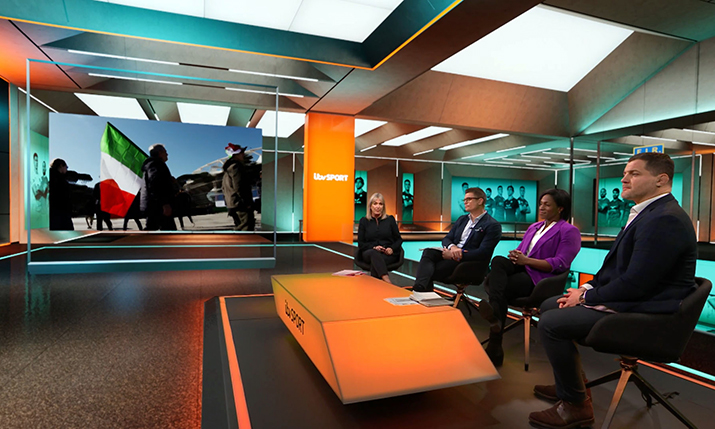
With a knowledgeable team on board, and lots of testing, the process of getting the new studio to air has been “really enjoyable” for McNamara.
“Jim and Toby are brilliant at what they do, and they’ve had a lot of experience. So I felt very comfortable in their hands. [The ITV team] have had a lot of own experience of doing AR and VR. At the Russia 2018 World Cup. At Euro 2020. Combined with the designers, and MOOV who are also highly experienced, and they have the set-up at Timeline, it didn’t feel fraught at all. The technology worked. The camera systems worked. The key was testing. Having the time to learn.”
Sports Graphics Spotlight Register for the SVG Europe online event, with speakers including Epic Games business director for Unreal Engine, broadcast and live events, BK Johannessen. For more information and to register click here
Although launched for the Six Nations, the virtual set will be used again, on other sports coverage. Although which ones, and how, McNamara is keeping close to his chest for now.
“The structure of the space will stay the same but we can re-skin it,” he says. “That’s the beauty of it. We can change the design of the AR as well. Once you have built the model, the colour of the model, and what you put in the model, is almost limitless.
“It’s incredibly early stages but I am really pleased with the end product. I think it looks really sophisticated, unlike anything that is out there at the moment. It’s got quite a unique, grand feel to it. What happens next? It depends on what [sports or events] we have and how we decide to editorialise them. And that’s still up for discussion. But, the possibilities are endless. We’re getting up to speed now. We’re happy and we’re just going to enjoy it.”

ITV Sport’s Six Nations coverage continues on Saturday 25 February with Italy vs Ireland.
Pictures: Jim Mann and ITV Sport

